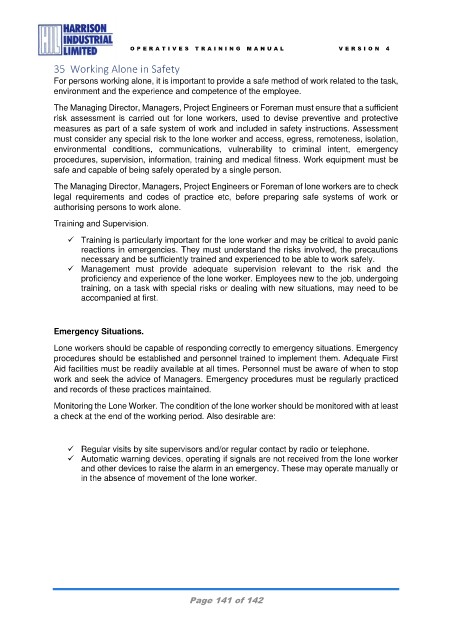Page 142 - HIL Operatives Training Manual V4 16022024_Neat
P. 142
O P E R A T I V E S T R A I N I N G M A N U A L V E R S I O N 4
35 Working Alone in Safety
For persons working alone, it is important to provide a safe method of work related to the task,
environment and the experience and competence of the employee.
The Managing Director, Managers, Project Engineers or Foreman must ensure that a sufficient
risk assessment is carried out for lone workers, used to devise preventive and protective
measures as part of a safe system of work and included in safety instructions. Assessment
must consider any special risk to the lone worker and access, egress, remoteness, isolation,
environmental conditions, communications, vulnerability to criminal intent, emergency
procedures, supervision, information, training and medical fitness. Work equipment must be
safe and capable of being safely operated by a single person.
The Managing Director, Managers, Project Engineers or Foreman of lone workers are to check
legal requirements and codes of practice etc, before preparing safe systems of work or
authorising persons to work alone.
Training and Supervision.
✓ Training is particularly important for the lone worker and may be critical to avoid panic
reactions in emergencies. They must understand the risks involved, the precautions
necessary and be sufficiently trained and experienced to be able to work safely.
✓ Management must provide adequate supervision relevant to the risk and the
proficiency and experience of the lone worker. Employees new to the job, undergoing
training, on a task with special risks or dealing with new situations, may need to be
accompanied at first.
Emergency Situations.
Lone workers should be capable of responding correctly to emergency situations. Emergency
procedures should be established and personnel trained to implement them. Adequate First
Aid facilities must be readily available at all times. Personnel must be aware of when to stop
work and seek the advice of Managers. Emergency procedures must be regularly practiced
and records of these practices maintained.
Monitoring the Lone Worker. The condition of the lone worker should be monitored with at least
a check at the end of the working period. Also desirable are:
✓ Regular visits by site supervisors and/or regular contact by radio or telephone.
✓ Automatic warning devices, operating if signals are not received from the lone worker
and other devices to raise the alarm in an emergency. These may operate manually or
in the absence of movement of the lone worker.
Page 141 of 142

